There and Back Again: A Highland Circuit
Open canoeing expeditions can be a fantastic way to explore the outdoors, and particularly to see Scotland’s stunning rivers. Read about Paddlesport Instructor George Fell’s 2022 trip around the Highlands . We hope for these adventure stories from our staff to be inspiring; but please be aware that not all canoe expeds have to be like this one!
Check out our open canoeing courses & trips
So the first thing you should know about this trip is that it was definitely Stephen’s idea.
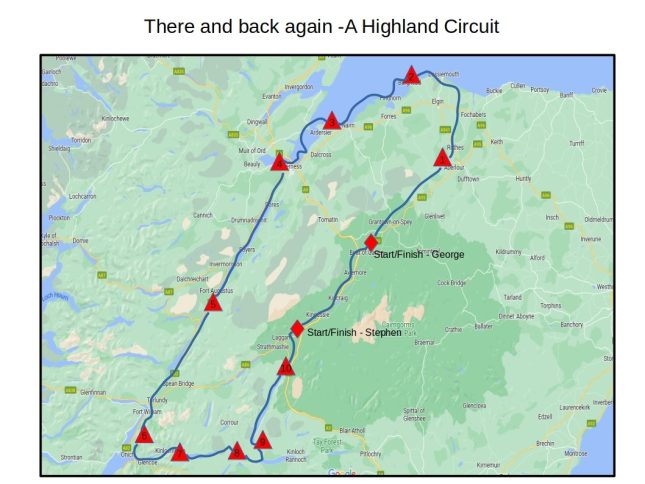
We’d been talking about trying to find time off to do a decent length Scottish trip together for about 5 years, and finally, back at the start of 2022 it looked like we might actually get a few weeks when we were both free.
Now some of you might be wondering whether the start of March offers the best weather and daylight to do a trip, and you might be right, but we both work in the outdoors and we’re both busy in the summer. It was March or nothing…. so it was March.
Stephen lives in Newtonmore. He’d just finished his winter mountaineering and climbing instructor assessment, so this trip in some weird way was his rest and recuperation after a winter spent postholing his way around the Cairngorms. In contrast I’d spent the winter moving numbers around on spreadsheets and eating cake, so Stephen’s R&R was also my attempt to get my ageing body in shape for the rapidly approaching paddling season.
Another attraction of this particular trip was that no cars were involved, so we could have a genuinely low environmental impact expedition.
Getting started
So – Stephen set off from Newtonmore, down the Spey, giving me a morning to run around, sort kit, find the missing bits of my trolley, so I could drag me and my boat down to the Spey in time to meet him.
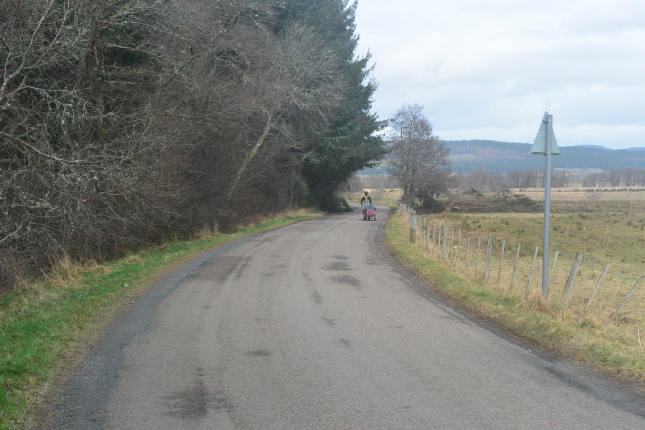
Trolleying is a skill in itself – and one that definitely wasn’t in evidence as I set off from my home in Nethy Bridge down to the Spey. Dragging through the village people looks varied from intrigued, through pitying, on to “don’t make eye contact with the nutter – he might speak to me!”
I didn’t have my boat very well balanced, I hadn’t sorted out a good system to attach it to me and I found it all fairly hard work with one dry capsize. 11 days later, the same journey in an uphill direction was a complete doddle. Whether that was better systems or whether I’d just reset the bar for suffering I’m still not sure.
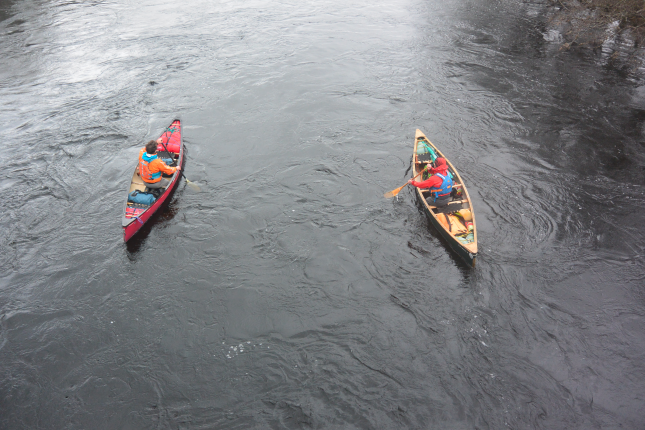
And we’re off. We both know the Spey fairly well. With both heads down we’re concentrating on making miles rather than stopping to play. We’d also both chosen to wear separates rather than dry suits, trading the risk of wet clothes for a bit more flexibility to regulate our temperature – so we both played it cautious, taking the guaranteed dry lines down the rapids at the Washing Machine and Knockando. We camped at Craigellachie just as it was getting dark.
Day 2
I made the rookie error of leaving my river boots in the porch of the tent, so they froze pretty solid overnight. We were up before first light, and I had a few minutes prancing around like some obese yorkshire ballet dancer, until I my boots finally thawed enough to accept my feet.
And then we’re off. Spey Bay came a few hours later, and the first of many hospitality disappointments, when we discovered that the cafe didn’t open for another 3 days.
A bit of chat about the best line through the breakers and then out onto the sea, to find that what we’d thought were 3 foot breaking waves were more like 6 inches.
Onwards to Lossiemouth – I used to work on the base there years ago and was dredging the depths of my mind for the location of the chip shop. We found it. Hooray. It was shut. Boo.
Chip shop number; the same triumph and the same tragedy. So after a slightly disappointing Co-Op sandwich we were back out onto the sea.
We reached the bay near Sculptors cave out towards Hopeman about 15 minutes after sunset, so headtorches on for a fairly gentle surf into the bay. It’s amazing how big little waves feel in the dark – followed by a quick dram, tent up and sleep.
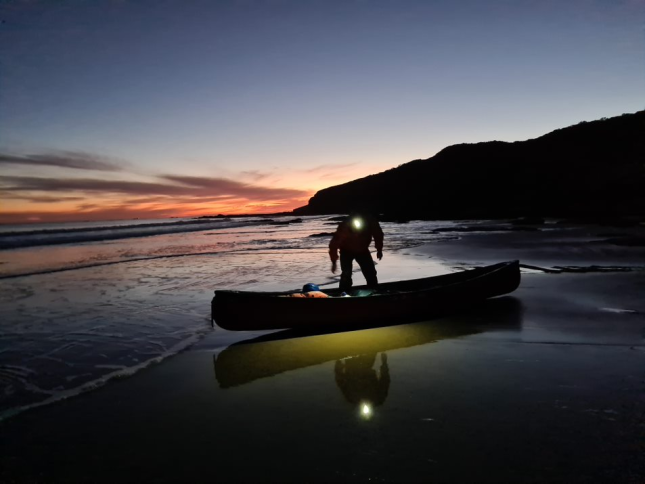
Day 3
Putting it charitably, Stephen doesn’t object to an early start. Throughout the trip, the weather kept changing about half a day, to a day ahead of when we’d want it to. It was supposed to go Easterly about half a day before we got to Spey Bay (it didn’t). It was supposed to go Northerly about half a day before we got to Inverness (it didn’t).
If we’d set off a day later than we did, I don’t think we’d have made it round. So it became something of a a running joke that sometime in the afternoon, one of us would suggest pushing on for about 15km more than we’d planned to do. By a week in it just became a look, replied to with a shrug and “Aye, I suppose so”.
Up before dawn saw us through Findhorn mid-morning (where we found fresh water, but again no food) and on past Nairn.
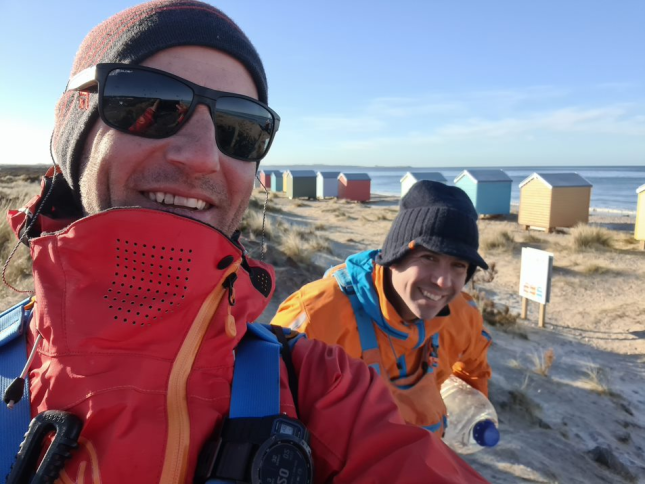
Our first night camping on sand. Round one of the competition to keep the beach out of my tent, sleeping bag and pants. Let’s be kind and say say round one was a draw.
Day 4
Another early start, with the wind with us and stunning skies behind as the sun comes up.
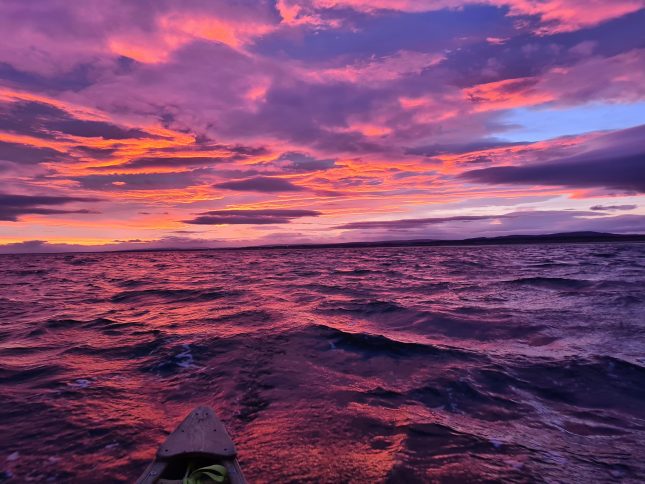
It was a firing day at Fort George, so a bit of a detour to keep out of the danger area. Stephen’s sailing is definitely a thing of beauty, he’s really good at changing the trim and the edge to get the boat working with the sail rather than drifting sideways and ploughing its way through the water. He was very patient in waiting for me.
Approaching Fortrose the wind picked up and was definitely in our faces. By the time we got to Channonry point, it was a decent force 5. I was keeping up with a dog walker on the beach, but only just. We called a temporary break and obtained our first fried breakfast of the trip.
The cafe had some tunes playing in the background, specifically Dolly Parton and Kenny Rogers singing Islands in the Stream on repeat, which is also how it remained inside my head for the pretty much the rest of the trip.
Buoyed by our fry up we decided that the wind had dropped – it hadn’t – and with wind against us and tide with us the game was to stay just on the south edge of the race where the flow would help us, but the waves weren’t going to swamp us. For the sea kayakers, imagine paddling a sea kayak where you’ve lost both your hatch covers and your spraydeck. Eventually we lost any useful push from the water and were just thugging our way into wind.
Another thing about Stephen – not only is he a really talented paddler, he’s also strong.
I usually rely on either strength or cunning to get me through, (generally strength first and cunning second). It was slowly dawning on me that on this trip I was going to have to rely on sheer bloody mindedness and stubbornness.
As the wind picked up, we rafted up into a box tow. As the day wore on – maybe ground on would be better – we ended up using all the traditional open boating skills; rafting, tracking, poling, and eventually just tying the damn thing to my back and wading through the water.
As darkness approached, the wind dropped off and we paddled up against the tide, under the Kessock Bridge and made it to the end of the Caledonian Canal.
As we’re setting up camp at Clachnaharry, opposite what I’d misremembered as a pub, but was quite clearly a house, there was a bit of curtain twitching going on. The owner came out and I thought we were about to get told off for camping. Actually, they were lovely, and genuinely interested in our trip. In fact, throughout the trip everyone, Lyndsey in Inverness, the engineers working on Cullochy Loch, the residents at Kytra, Mary and Graham at Kinlochleven were all lovely, kind and helpful to the pair of increasingly smelly and dishevelled paddlers they encountered.
By this time (day 4 I think, but I’m already losing track of which day we’re on) the long days are taking their toll; my right wrist is starting to hurt, my hands are blistering, and Stephen’s feet are starting to fall to bits.
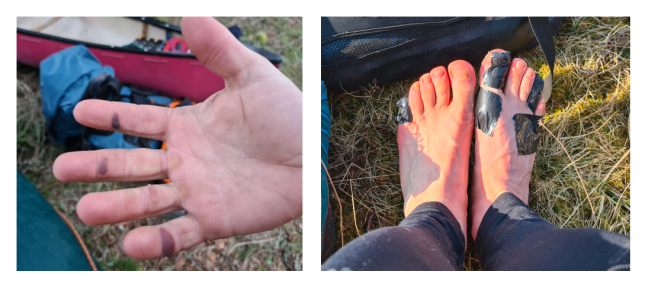
But…we’ve made in into the great glen, the wind is forecast to be N’ly F3, and I’m looking forwards to kicking back whilst the canoe sails its way towards Fort Augustus.
Day 5
So of course, we wake up to another cold morning with force 2 from the SW, improving to no wind. The anticipated sail and surf down Loch Ness become a long slow plod. I normally paddle right-handed, but by now my wrist is telling me I’m a leftie. As the sun went down, we picked up a cold breeze, pushing in the right direction, so a bit of nocturnal sailing got us to Fort Augustus around 2100. At that point, being the highly trained athletes we are, we looked after our essential nutritional needs – Pizza at the end of the canal. Up the canal locks and on to camp at Kytra around 2300.
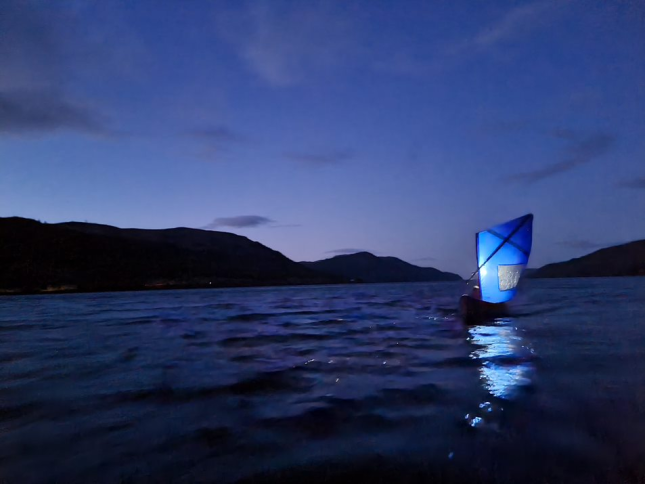
Day 6
Another early start, – you may notice a pattern emerging here – quite grey at first, but the clag burnt off to leave a stunning day (naturally with no wind). Yet again, the wind was due to turn SW’ly the following day, so it made sense to push as close to Loch Leven as we could get. On the other hand, by this stage the bottom of my right arm was growing a noticeable bump and if I tried to wave my wrist was making the same grinding noise that the clutch cable makes on your car shortly before it snaps.
Onto the Lochy – with absolutely no memory of the rapid at Torcastle, but it all went fine. A quick stop for luxuries at Fort William – sweetners, lip balm and fresh milk for Stephen, Ibuprofen, Diclofenac and a compression bandage for me. By this time, I’m damp and smelly enough that social distancing (remember that!) in Morrisons takes care of itself. Then onwards, in the dark down to Black Rock.
Day 7
Negotations with Stephen, who bear in mind is part terminator and thus has no need for sleep, allow a lie in until around 0700. Then it’s onwards, with the tide, through the Corran narrows, dodging the ferry. It’s a stunning day, with barely a breath of wind. Poling up against the tide at Ballachullish and quick sprint at the Loch Leven narrows, more poling up the river Leven, but otherwise it’s cruising all the way.
A quick trolley into Kinlochleven, with coffee and cake at the ice factor, and then it’s time for the first portage of doom.
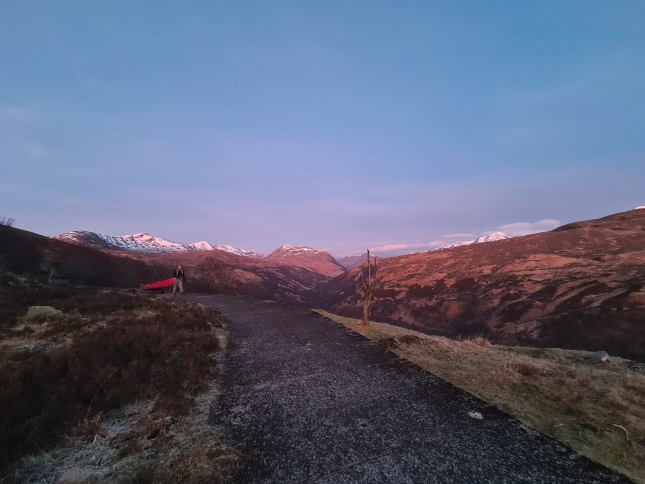
A word on portages. Any canoe trip that joins different drainages together inevitably involves portages. There is a sort of masochistic pleasure that comes from choosing when to swap from tracking, to dragging, to trolleying, to carrying. How long to set your bow line, and whether to wrap it around your waist, chest or shoulder. Picking the right line through boggy heather is just as critical as it is on a rapid… but it is quite definitely type 2 fun.
This one, gaining 320m of height over 6 or 7 km turns out to be OK. The trail starts up a forestry track and then goes on top of the aqueduct that takes the water from the the Blackwater reservoir down into Kinlochleven. Once you’re on the aqueduct it’s smooth concrete slabs with the occasional hurdle where a new vehicle track has been built.
The highlight of the night is meeting Mary. The portage path from the forestry track onto the aqueduct goes through her back garden. She makes us a cup of tea and says the portage is getting quite popular now. When I ask what that means, she says that 2 people did it last year.
A bit falls off my trolley, so we camp early (well 2200ish) so I walk back a few km to find it whilst Stephen very kindly pitches my tent.
Day 8
Onto the Blackwater Reservoir the following morning. If you want a grim read I recommend “Children of the Dead End” by Patrick Macgill. It’s a thinly fictionalised account of the grim conditions the navvies and their families suffered whilst building the dam there early in the last century.
More cheerily we get onto the loch and it’s filled with water in its liquid form….just. We paddle the slush puppy across to the other end of the loch.
There’s another great book called “Beyond the Paddle” by Garret Conover which talks all about paddling through and over ice, just the right sort of weighted ice axe to attach a rope to and throw ahead of you to pull yourself along, when the ice is too hard to paddle through but not hard enough to walk on.
Fast forward to the other side of the loch. Stephen says “it’s only 35m of height to gain. I think it’ll be OK”. I was more pessimistic. On this occasion I take absolutely no satisfaction in being right. It was horrendous. The next 9km was spent dragging our boats up the river, over rough granite steps, or across soggy moorland with peat hags and ditches – it took about 6 hours.
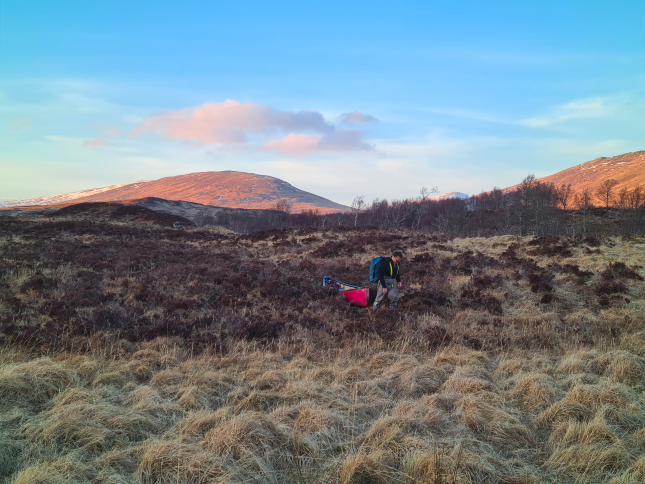
Every trip has its physical and mental low point and this was definitely mine. My personal “suffer-meter” was reaching levels that it hadn’t reached since 2015 on a portage in the Himalaya. My head is down and so are my spirits. There’s a great passage in Mike Stroud’s book, of his journey across the Antarctic when he talks about working out if he could kill Ran Fiennes, make it look like an accident and abandon the trip. Well, I don’t think Stephen and I got that far, but certainly another day like that and I’d have been wanting to bail out.
Day 9
Fortunately, we didn’t get another day like that. A strong headwind made it another day of portaging instead of paddling the Gaur down to Loch Rannoch. But it was a portage on a glorious tarmac, with curious looks from the odd car that came past us. Even the track up to the Loch Ericht was straightforward, and we arrived close the the dam in time to put our tents up before the rain and the worst of the wind arrived.
Day 10
Start to sail up Loch Ericht we started off with a lovely steady force 3-4 and made great progress.
As we got approached the first corner you see it was going to get gustier – you’re spending more time looking behind you to see the squalls on the water before they hit you.
The wind continues to pick up, and with more fetch, there’s more waves. Rapid progress now, and really paying attention. In another 10km the loch narrows, it’s surely going to funnel there. On the plus side I temporarily don’t have “islands in the stream” going around my head.
As always in trip write ups there are no images of the exciting bits because you’re prioritising staying upright over taking photos.
One gust took me by surprise – the sail gybes, the mainsheet slams across me, catching on the back of my BA. It took me far too long to quick release it and when I do I end up with a flapping sail with the sheet snaking around in the air out in front of me. Meanwhile Stephen had one pretty big surf into nearly broaching as the wave broke.
I reckon it was gusting somewhere around force 7. The waves were breaking most of the time and when the gusts hit there was plenty of spray being blown off the wave tops and on ahead of the waves. The waves picked up to a point where you were no longer trying to surf, but instead swapping between rudders and backwards strokes to keep the canoe pointing downwind.
We both discover a feature of our sails, which is that the pocket that holds the end of the boom fails in those winds. Which is probably not a bad (if unintentional) safety feature.
We pull off the water and decide to wait it out for a few hours.
Chatting between our tents, it turned out we both had the same thoughts.
1.) If we’d fallen in, that we’d probably have ended up walking to Dalwhinnie at the far end of the loch.
2.) If the other person had fallen in, we probably wouldn’t have been able to do much to help.
3.) Whilst we were on the water it wasn’t the right time to share those thoughts with the other person.
It’s still windy, but not crazy windy. By this stage my wrists are in a state where I’m asking Stephen to roll up my dry bags for me. Anyone who knows me and knows how awful I am at asking for help, will realise this is pretty serious.
We make it along to the dam at the Dalwhinnie end of the loch, and set up camp behind the dam, which is another pretty damp, soggy night.
Naturally we arrive in Dalwhinnie in time for the cafe to be shut, but we know that we’ve more or less done it. Worst case scenario we trolley the 15km to the Spey and paddle from there.
Day 11
Waking up in the night it’s suspiciously quiet. Stepping outside there’s a decent cover of fresh snow. Luckily by this stage I’ve learnt to keep my boots inside the tent. Inside the tent the Thermarest is a dry island on a soggy groundsheet.
The following day the cafe is open, and along with a couple of truckers from Leeds, we’re at the very front of the queue. Fuelled up for the day, we’re on to the River Truim, which luckily is just about paddleable with the previous night’s snowmelt. There are a few nice rapids and then we’re at Falls of Truim.
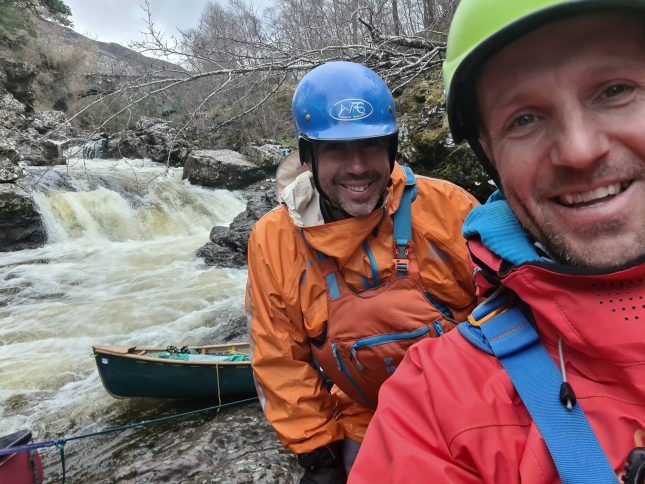
We drag and scrape round the first couple of drops and then get into position to line the last one. It’s a bit of a tricky corner to get round and it’s my boat up first… and it fits. Stephen’s boat next and then it’s straightforward river paddling back onto the Spey and back to Newtonmore.
And that’s it, Stephen’s done and I’m on my own, in an area I know well. Through Loch Insh – the clouds are going the right way, but the surface wind is not being kind to me. Fortunately, the River Feshie is on turbo, so once that joins the Spey it’s an easy glide down to Aviemore. A quick coffee and a bacon roll in Aviemore as it gets dark (I was a very bad vegetarian on this trip). Then my head torch gives up the ghost, so I’m now navigating down the Spey by very limited moonlight and mostly by listening. Jenny kindly meets me with a spare headtorch at Boat of Garten and that makes life much easier. An easy 3km trolley, a quick text to Stephen to let him know I’m alive and then I’m back home and running a bath.
As usual the smell fairies visit my clothes whilst I’m in the bath. The clothes that smelt fine when I took them off now smell like something has died inside them.
Journey completed!
And that’s it. Done. 11 days. 440Km. One “rest” day where we only trolleyed for 6 hours. Every other day between 10 and 14 hours on the water. Mission somewhat improbably accomplished.
We were lucky in all sorts of ways.
We were lucky with the weather. With the people we met. And most of all I was really lucky to have Stephen as an adventure buddy, who made this trip happen and who I’ve probably libelled several times in this blog.
I don’t think there needs to be learning or any moral from a trip, but if there is one from this adventure, it’s that whatever craft and whatever environment, there are loads of places to visit, and trips that just don’t get done very often. We are so lucky in Scotland to have the right of responsible access – we can look at a map, and then do a trip.
With fuel prices going ever upwards and the environmental impact hopefully becoming a bigger factor in our choices, there are loads of great local adventures, which aren’t always in the guidebooks.
So, if life lets you, look at a map of Scotland and dream up some adventures. Loads of them will be awful, but some will be gems.
Many thanks to Peak PS for the kit. The Adventure Double kept me dry but not too sweaty and the Ocean Bothy made life considerably less miserable when the sky got dark and I got shivery.
Photo credits: Stephen McCall and Jenny Allen